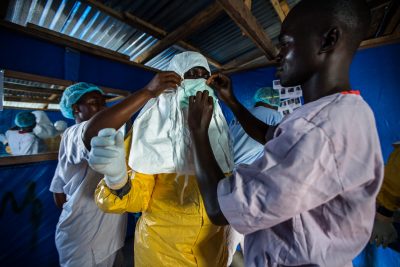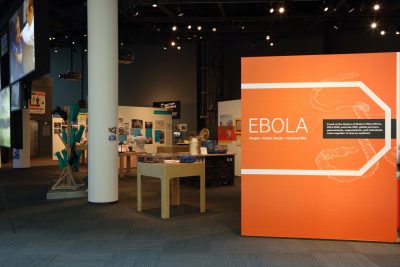Public health and public history: Rapid response to the Ebola crisis
07 March 2018 – Louise Shaw
rapid response, The Public Historian, TPH 40.1, TPH Rapid Response, disaster planning, condolence collecting
Editor’s note: This is the second post of a series that continues the conversation begun in the February 2018 issue of The Public Historian with the roundtable “Responding Rapidly to Our Communities.”

Felicia, a 29-year-old Liberian nurse, prepares to go inside the Ebola patient ward to draw blood from confirmed patients in Bong County, Liberia on October 9, 2014. Photo credit: Morgana Wingard, USAID
As curator of the David J. Sencer CDC Museum, I collect, present, and interpret the Centers for Disease Control and Prevention’s history. My projects have often benefited from insights provided by a historic perspective, such as exhibitions about smallpox eradication in the 1960s and ’70s and the unfolding of the AIDS epidemic in the 1980s. At the same time, CDC is constantly in the news. How to document and present contemporary events from Zika to the opioid epidemic requires nimble judgment.
In this context, I followed reports of Ebola outbreaks in Guinea, Liberia, and Sierra Leone in early 2014. As outbreaks grew into the most widespread Ebola epidemic ever encountered since the disease was first detected in 1976, I heard firsthand reports from CDC colleagues and read coverage of an epidemic spinning out of control. In August 2014, media frenzy focused on CDC and nearby Emory University Hospital when Emory treated two American health workers who had worked in Liberia. As more CDC staff were deployed to West Africa and across the United States, controversies about the global response elevated. Cases grew exponentially in the highly impacted countries, and in September, President Obama announced the escalation of the US government’s response.
Clearly, we were living in extraordinary times, and the museum made documenting the epidemic a priority. In September 2014, we made a call within CDC for Ebola-related artifacts and documents, describing it as “Rapid Response Collecting,” using a term that had been part of public health lexicon since the 1950s and that had only recently been appropriated by museums. Despite the intensity of the situation (by the time the epidemic was controlled, nearly 4,000 CDC staff had participated), responders donated items such as diaries, posters, T-shirts, community gifts, and photographs, which formed the foundation of our now extensive Ebola collection. We archived internal documents, such as incident management reports and communication resources, and tracked the extensive media coverage, including print articles, broadcast, and websites.
The epidemic was still very much going on in early 2015 when I began conceptualizing a major exhibition. An exercise in contemporary history, I wanted its scope to be far broader that just a focus on CDC: not only was CDC part of a large global response, but also it was critical to tell the stories of the people most impacted by Ebola—the citizens of Guinea, Liberia, and Sierra Leone. I created an exhibition framework that went through eighteen revisions informed by unfolding events and by input provided by CDC responders, US government partners such as USAID, and NGOs such as The Carter Center, Médecins Sans Frontières, and Focus 1000. It was critical to be flexible as the story unfolded in real time, and to dive deeply, but diplomatically, into its many controversies.
Also shaping the exhibition narrative was our oral history project. Oral historian Sam Robson and I teamed up to talk with CDC leaders and staff who had “worked in the trenches” about their experiences. These meetings informed both exhibition development and Sam’s formal interviews.

Entrance to “EBOLA: People + Public Health + Political Will” at the David J. Sencer CDC Museum. Image credit: Mike Jensen
Exhibitions are visual experiences, and curating this exhibition was a dance between the unfolding narrative and the visual evidence. I plowed through copious international photographic and video documentation. It was important to identify objects to both inform and support the exhibition outline: in March 2016, Dr. Kali-Ahset Amen of Emory University traveled to West Africa and collected Ebola survivor kits, banners, and materials from the faith communities. As the epidemic wound down, CDC staff escalated their efforts to collaborate with the museum: for example, one responder preserved a whiteboard used for tracking the last major Ebola cluster in Freetown. (A practical challenge: although I had managed international shipments previously, shipping from West Africa was a new experience.) Not to give short shrift to what occurred in the United States, including “Fearbola” and quarantine controversies, I collected Ebola monitoring kits issued to travelers from West Africa and items such as instructions on doffing personal protective equipment that hung in Bellevue Hospital.
Ebola in West Africa was a humanitarian and public health crisis of epic proportions. Years ago, as a young curator at the Atlanta Historical Society (now History Center), I overlooked collecting materials relevant to the electrifying story of the Atlanta Missing and Murdered Children. Years later, I realized my mistake when preparing a CDC exhibit about this episode, and I vowed to be accountable in the future for collecting history in the moment. Documenting the Ebola epidemic was such an instance. I feel confident that we made a good first pass in capturing histories and collecting materials that engage audiences today and that will be useful to public and medical historians in the future.
~ Louise E. Shaw is a museologist and curator. Previous to joining the staff of the David J. Sencer CDC Museum in 2002, she served as assistant curator at the Atlanta Historical Society, executive director of Nexus Contemporary Art Center, and as a consultant to national and international art and history organizations.



